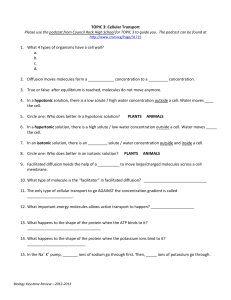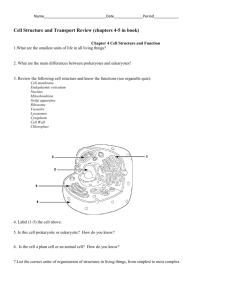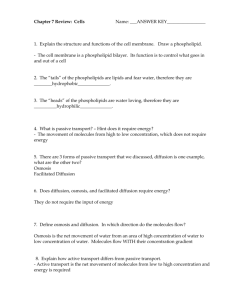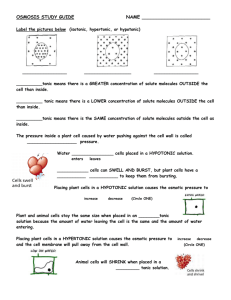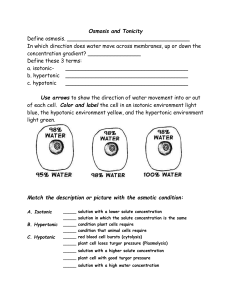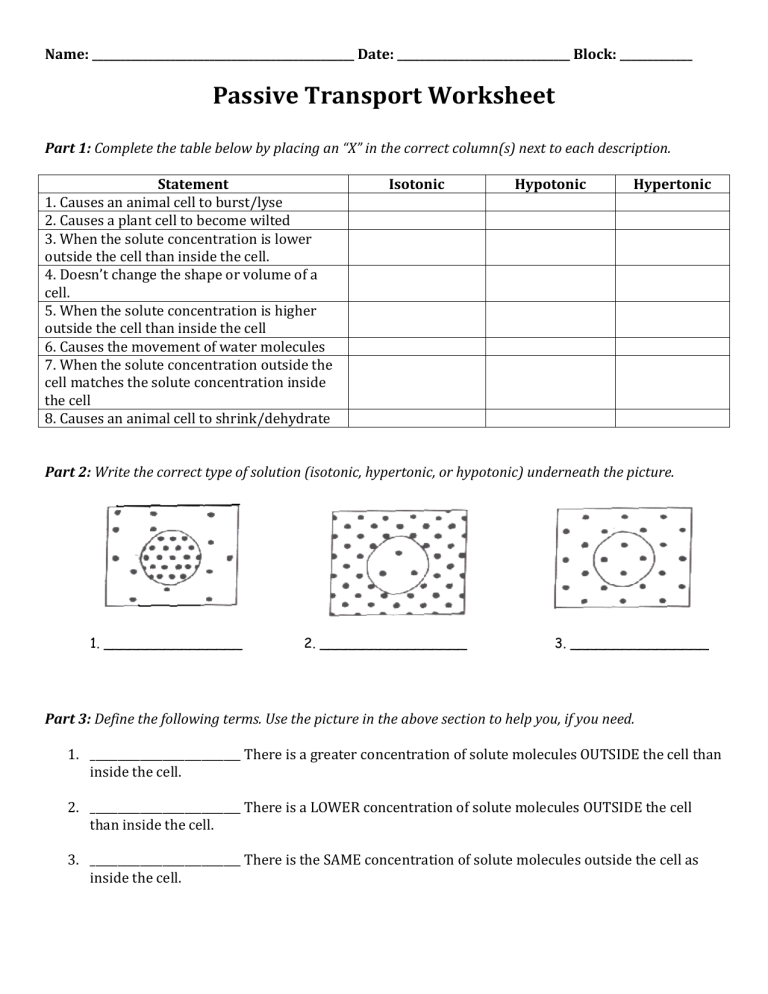
Name: _______________________________________________ Date: _______________________________ Block: _____________ Passive Transport Worksheet Part 1: Complete the table below by placing an “X” in the correct column(s) next to each description. Statement Isotonic Hypotonic Hypertonic 1. Causes an animal cell to burst/lyse 2. Causes a plant cell to become wilted 3. When the solute concentration is lower outside the cell than inside the cell. 4. Doesn’t change the shape or volume of a cell. 5. When the solute concentration is higher outside the cell than inside the cell 6. Causes the movement of water molecules 7. When the solute concentration outside the cell matches the solute concentration inside the cell 8. Causes an animal cell to shrink/dehydrate Part 2: Write the correct type of solution (isotonic, hypertonic, or hypotonic) underneath the picture. 1. ________________ 2. _________________ 3. ________________ Part 3: Define the following terms. Use the picture in the above section to help you, if you need. 1. ___________________________ There is a greater concentration of solute molecules OUTSIDE the cell than inside the cell. 2. ___________________________ There is a LOWER concentration of solute molecules OUTSIDE the cell than inside the cell. 3. ___________________________ There is the SAME concentration of solute molecules outside the cell as inside the cell. Part 4: Match the definition to the terms in the word bank. Words may be used more than once! 1. ________ The swelling and bursting of animal cells when water enters is called? 2. ________ A cell bursts happens when the cell is placed in this type of tonic solution? 3. ________ The shrinking of plant cells when water leaves causing the membrane to pull away is called 4. ________ The membrane in #3 happens when the cell is placed into this type of tonic solution? 5. ________ The shrinking of animal cells that are placed in a hypertonic solution is called? 6. ________ Cells will stay the same size when they are placed into this type of solution? Word Bank A) Isotonic B) Hypertonic C) Hypotonic D) Lyse E) Plasmolysis Part 5: Multiple Choice. 1. _______ The substance that dissolves to make a solution is called ________________________? a. Diffuser b. Solvent c. Solute d. Concentrate 2. _______ During diffusion molecules tend to move ______________________________. a. Up the concentration gradient b. Down the concentration gradient c. From an area of lower concentration to an area of higher concentration d. In a direction that doesn’t depend on concentration 3. _______ When the concentration of a solute inside and outside a cell is the same, the cell has reached? a. Maximum concentration b. Homeostasis c. Osmotic Pressure d. Equilibrium 4. _______ The diffusion of water across a selectively permeable membrane is called? a. Active transport b. Facilitated diffusion c. Osmosis d. Phagocytosis 5. _______ Energy for active transport comes from a cell’s _____________________? a. Golgi complex b. Nucleus c. Mitochondria d. Lysosomes 6. _______ All of the following are kinds of passive transport EXCEPT ________________? a. Diffusion b. Facilitated diffusion c. Osmosis d. Ion Channels 7. _______ When molecules move DOWN the concentration gradient it means they are moving from ___________________________? a. An area of low concentration to an area of higher concentration b. An area of high concentration to an area of lower concentration 8. _______ The pressure exerted by water moving during osmosis is called _______________ pressure? a. Tonic b. Diffusion c. Osmotic 9. _______ Gases like oxygen and carbon dioxide move across cell membranes using? a. Ion channels b. Diffusion c. Facilitated diffusion Part 6: Complete the transport terms. Some letters have already been filled in for you! 1. Active transport requires _E_ __ __ __ __ __ to move molecules across membranes. 2. _A_ __ __ is the molecule that provides the energy for active transport. 3. _D_ __ __ __ __ __ __ __ __moves oxygen and carbon dioxide molecules from a high concentration to a low concentration across membranes. 4. The cell organelles that burns glucose and provides ATP for active transport are the _M_ __ __ __ __ __ __ __ __ __ __ __, 5. Water moves across membranes by _O_ __ __ __ __ __ __. 6. A small membrane sac used to transport substances out of the cell = _V_ __ __ __ __ __ __ 7. _P_ __ __ __ __ __ __ transport does NOT REQUIRE energy. 8. A cell placed in an _I_ __ __ __ __ __ __ __ solution neither swells or shrinks because the concentration of molecules outside the cell is the same as inside. 9. A solution in which there is a HIGHER concentration of molecules OUTSIDE the cell than inside = _H_ __ __ __ __ __ __ __ __ __. 10. A CONCENTRATION _G_ __ __ __ __ __ __ __ forms whenever there is a difference in concentration between one place and another. 11. A solution in which the concentration of molecules outside the cell is LOWER than inside = _H_ __ __ __ __ __ __ __ __. 12. When molecules move from high to low along a concentration gradient we say they are moving “_D_ __ __ __” the gradient. 13. _O_ __ __ __ __ __ __ pressure is caused by water inside a plant cell pushing against the cell wall. 14. The shrinking of a plant cell membrane away from the cell wall when placed in a hypertonic solution is called _P_ __ __ __ __ __ __ __ __ __ __. Part 7: Diagrams • Look at the diagrams below. The black dots represent solute molecules dissolved in water. • In which beaker is the concentration of solute the GREATEST? A or B A B Part 8: Matching 1. _______ Solution with a lower solute concentration (more water) Word Bank 2. _______ Solution in which the solute concentration is the same A) Isotonic 3. _______ Condition plant cells require B) Hypertonic 4. _______ Condition that animal cells require C) Hypotonic 5. _______ Red blood cells bursts (cytolysis) D) Lyse 6. _______ Plant shrinks (Plasmolysis) E) Plasmolysis 7. _______ Solution with a higher solute concentration (less water) Part 9: Label each picture as isotonic, hypotonic, or hypertonic. Pay attention to the arrows!
